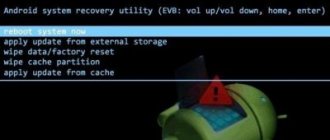What is Recovery ROM and Recovery Mode
Xiaomi Recovery Mode is a special system recovery mode that, in some cases, allows you to correct the situation if the smartphone does not want to boot. Most often, a factory reset is used to solve the problem.
There are two types of Recovery:
- Stock (official) is a recovery pre-installed on a smartphone by Xiaomi developers (Mi, Redmi, POCO). It is installed along with the standard MIUI firmware. There are not very many functions, so it’s easy to understand it even without knowing English. This is what we will talk about next.
- Custom (unofficial) - this often means custom TWRP recovery. This is a powerful tool for installing patches, mods and firmware on your phone. To install such a recovery you need to have certain skills.
There is a Recovery ROM - this is a special type of firmware for installation in stock recovery mode. Fastboot bootloader mode is not suitable for this type of firmware. Recovery ROM is always in ZIP format.
Attention! When working with recovery, you need to be careful and strictly follow the instructions. If you do something wrong, you can lose all user data and even damage the operating system.
There is no need to confuse Recovery ROM with OTA updates - they are different things. You can read in detail about their comparison in the material about OTA updates.
Checking and calibrating the phone via the cit menu
So we entered CIT. Next you need to test and calibrate the main elements of the gadget.
The items and names of the engineering menu in different gadgets and versions of miui differ significantly: Hardware test is found in Redmi 7A, mi 5, SIT in Xiaomi mi 9 SE or Engineering Mode in Redmi 5 plus, 4x, as well as the settings themselves.
In “Keyboard and vibration” you need to select the option to check this function on the device.
When testing, you will feel vibration for at least 10 seconds (Continuous vibration). Or will it be separate random vibrations (Start random vibration). If the function does not turn on, this indicates a device malfunction.
Led Test. This setting checks the flashlight function and the notification light.
In "Touchpad Edges" you need to paint all the squares green. If part of the screen remains unpainted, this indicates a lack of sensitivity in this place.
In LCM we check the screen for dead pixels with different backgrounds. Click Next to change the background color.
The “magnetic sensor” is calibrated by rotating the phone around its axis.
"Receiver" and "Speaker" test the sound. A woman's voice will say two numbers and you will need to press them in the correct order.
How to enter Xiaomi recovery
There are two simple ways to enter recovery:
- Using smartphone keys - the method works on all versions of MIUI.
- Through the MIUI menu - starting with MIUI 12, this option has been removed.
Logging into recovery on all Xiaomi smartphones follows the same algorithm. To do this, you do not need to navigate through the MIUI settings or have any special skills.
Instructions on how to enter recovery on Xiaomi:
- Turn off your phone completely.
- Press the Power and Volume Up buttons at the same time.
- Do not release the buttons until the Android logo appears on the screen.
- Wait 10 seconds.
- The phone will vibrate and the recovery menu will appear on the screen.
When starting the mode, the power and volume buttons must be held until the logo appears on the screen.
On MIUI 11 firmware, it is possible to enter Recovery mode directly from the settings.
- Launch the Settings app.
- Go to “About phone” → “System update”.
- Click on the three dots in the top right corner of the screen.
- In the menu that appears, select “Reboot to Recovery Mode.”
MIUI 12 removed the ability to open recovery through three dots. Apparently, people often accidentally got into it, but couldn’t get out of recovery mode themselves... Perhaps Xiaomi will return this functionality in MIUI 12.5 or MIUI 13, but there is little hope.
Manual test selection
This is the most difficult item in the Android engineering menu, because the user needs to independently decide on the testing mode. When you click on the corresponding subsection, a screen will open where 26 different tests will be available:
- Blacklight – tests the brightness of the display;
- Key – diagnostics of the functionality of physical buttons;
- TFlash – the user receives information about the state of the memory card;
- TouchPanel – checks the quality of the sensor;
- Bluetooth – will find all devices available using this technology;
- SIM Card – detects the presence of a SIM card;
- Vibration – will assess the correct operation of the vibration alert;
- Proximity Sensor – testing the function responsible for fading the screen during a telephone conversation;
- Gyro – assessment of gyroscope performance;
- G-sensor – determining the performance of the speed sensor;
- GPS – finds available satellites;
- Battery – assessment of charging and battery performance;
- Magnetic Sensor – checks the functionality of the magnetic sensor;
- FM – radio operation test;
- Optical Sensor – quality of operation of the optical sensor;
- LCD – when pressed, you can find out about the color quality of the display;
- Speaker – conducting a speaker test;
- Headset – evaluates the quality of sound reproduction. Here you can also understand how to increase the volume through the engineering menu on Xiaomi;
- Receiver – diagnostics of a standard speaker;
- Wi-Fi – searches for access points;
- Ring test – will test the speaking microphone for recording and playback;
- RTC – responsible for checking the built-in clock;
- LED – checks the notification indicator;
- Camera – diagnosing the photo module and flash;
- Torch – flashlight diagnostics.
By learning how to open the developer menu on Xiaomi, you can get a significant amount of useful information about the operation of your smartphone, as well as optimize energy consumption, configure sensors and diagnose all the main elements and functions.
Recovery Menu in MIUI and Android One
The menu in stock Recovery Xiaomi is divided into several levels. At each level there is a certain number of points in English. Therefore, it is worth taking a closer look at the translation and purpose of each menu item and tell us what it is used for.
Structure of the Recovery Menu and its translation into Russian:
- Reboot —regular reboot of the device. There are 2 reboot options available: Reboot to System (reboot to MIUI) or Back to Mai Menu (return to the previous menu).
- Wipe Data - allows you to clear all user data. It is the Wipe Data menu that is used if you need to reset your smartphone to factory settings. It also has 2 sub-items: Wipe All Data (delete all data) and Back to Main Menu (return to the initial screen).
- Connect with MIAssistant - allows you to connect your smartphone to your PC to restore the system. You will need a USB cable, a special program on your PC and a downloaded firmware file. There are corresponding instructions for working in this mode. If interested, write in the comments, we’ll tell you more about it.
Main Menu home screen on Xiaomi with MIUI.
The image above shows the recovery menu of a MI brand smartphone, as indicated by the inscription Mi Recovery 3.0. If it were a Redmi phone, then we would see Redmi Recovery 3.0. Apart from this inscription, they are no different.
Navigation through the recovery menu is carried out using the volume buttons. To select one or another item, you need to press the power button.
In Mi A series smartphones - A1, MI A2 (A2 Lite), Mi A3, the recovery is different from the standard version of other Xiaomi phones. This is due to the fact that the A-series comes with pure Android One, while the rest of the devices use MIUI.
Structure of the Recovery Menu for Xiaomi A-series smartphones:
- Reboot system now starts a reboot into the OS.
- Reboot to bootloader - selecting this item will reboot the phone into Fastboot mode.
- Apply update from ADB - starts a firmware update using a computer and a USB cable.
- Apply update from SD card - starts an update from an external memory card. You can install firmware from a flash drive through recovery only on Xiaomi A-series smartphones. On other phones, installation is possible only from the internal memory of the device.
- Wipe data/factory reset - reset to factory settings (Hard Reset).
- Mount / system - mount the system partition for manual manipulation with it.
- View recovery log - after selecting this item, recovery logs will appear on the screen. This is needed to diagnose errors.
- Run graphics test - the command starts a test of the smartphone's on-board graphics adapter.
- Run locale test - starts checking the phone's language and region.
- Power off —the item is used to turn off the phone’s power.
Recovery Menu on the Mi A3 smartphone.
The recovery in Xiaomi A series is much more functional than that used in MIUI. You also need to enter this mode: hold down the power button and volume up. You need to release the buttons when a picture with a disassembled robot and a red triangle appears on the screen.
TOP 5 productive Xiaomi smartphones according to AnTuTu rating:
- 1 Black Shark 4 Pro
867578 points - 2
POCO F3 Pro821847 points
- 3
Mi 11 Ultra817225 points
- 4
Mi Mix Fold815000 points
- 5
Mi 11 Pro804210 points
Increasing volume on Xiaomi: the easiest way (without root rights)
Due to the fact that some countries have certain restrictions on the level of noise produced, Xiaomi must comply with these laws in order to sell its phones in their territories. Therefore, if after changing the system files nothing has changed, or you want to increase the volume of the speaker without root rights, we recommend using this method.
The instructions are very simple, we only need 2 minutes of time and standard phone settings.
- Let's go to settings.
- Next, go to “Advanced Settings”.
- Now click on “Region”.
- We change our region to one of the available ones: North Korea, Taiwan or India.
- We check the volume after changing the region, preferably.
- If the problem is solved, we adjust the time zone.
Note! If it is stated for your model, it may not work in some regions.
Xiaomi firmware via recovery
Through stock recovery you can only update the firmware. First, you will need to download the corresponding Recovery ROM package in ZIP format. To do this, go to the archive with official Xiaomi firmware, select your phone model and download the required update version.
Please note that the OS version is higher than the installed one, since new Xiaomi smartphones do not allow downgrading the system version.
How to install firmware via recovery:
- Download the firmware zip file, rename it update.zip and move it to the root of your phone's internal storage.
- Turn off your smartphone.
- Press and hold the power button and both volume buttons at the same time.
- From the menu that appears, select Install update.zip to System One.
- Once the process is complete, return to the Back to Main Menu, select Reboot and reboot your phone Reboot to System to exit Recovery and boot into MIUI.
If you download the firmware and do not rename it to update.zip , then the Install update.zip to System One will not be in Recovery.
Before flashing the firmware, check the update file for integrity, for example, through Total Commander. If the firmware file is damaged, the update process will not complete. As a result, instead of a working phone, you will end up with a brick with constant loading (Bootloop). It is quite difficult to restore it.
Why do you need to reset Xiaomi to factory settings?
Every person who uses one or another smartphone often experiences a decrease in the phone’s performance, which can occur for various reasons: quite a long period of use, outdated firmware, settings failure, etc.
Resetting the settings or the so-called Xiaomi Hard Reset helps restore the phone and eliminate any problems that arise when using it through a complete update.
A settings reset is also used when replacing the firmware with a new one or when selling a phone, in order to provide the new owner with sufficient space for his data and protect his own.
It happens that the smartphone freezes while loading the logo, and the only emergency way to “revive” it is to reset the Xiaomi Mi settings by calling a special Main Menu.
How to reset settings through recovery
Resetting Xiaomi to factory settings through recovery (Hard Reset) returns the operating system to its original state (as when selling a smartphone). Hard Reset removes glitches, eliminates errors and corrects lags.
How to reset your phone via recovery:
- Turn off your phone completely.
- Hold down the Power and Volume Up buttons.
- In recovery, select Wipe Data.
- Click Wipe All Data - this means erase all data .
- Confirm the action by selecting Confirm.
- The reset procedure will start, after which you will see the message Data wiped successfully - translated into Russian as data wiped successfully .
All you have to do is return to the main menu, select Reboot and click Reboot to System so that the first boot after resetting the settings may take from 3 to 7 minutes. You cannot turn off your phone during the process.
Attention! During a reset, all user files will be deleted: photos, videos, music. All applications except standard ones will also be deleted. Therefore, before performing this procedure, you should create a backup copy (if the smartphone starts and there is such an option).
Opening methods
To prevent inexperienced users from inadvertently violating the factory settings of Xiaomi smartphones, including Mi5, Mi6, Mi8, Mi Note, as well as Redmi versions, the developers have protected the service menu from unauthorized intrusion with secret encryption.
There are two ways to access the Main Menu:
- using a special option in the basic settings of the mobile device;
- by entering a special set of characters.
Both methods are universal and suitable for all phones with the Android operating system, including the Miui 8 series.
Through settings
The procedure involves the user entering the service menu through the smartphone settings. Procedure:
- go to the engineering application;
- select the “About phone” tab;
- find the “Kernel version” section;
- Press five times to open the diagnostic program.
The menu is entered through the phone settings.
Access to the engineering menu allows you to check the availability of all options declared by the manufacturer and test their functionality.
Special code
An alternative way is to use the standard call function.
Instead of a phone number, enter a special set of characters: *#*#6484#*#*. In some cases, this code does not work on Redmi 3S smartphones. In such situations, you can try replacing the numbers in the code with 4636 or 3646633.
If none of the versions are suitable, you will have to look for other login methods.
How to exit Xiaomi recovery
There are two ways to exit Recovery:
- The simplest and most correct: select Reboot from the menu and click Reboot to System. This action will reboot the smartphone and initiate the start of the operating system.
- If for some reason it is not possible to use the Recovery Menu, simply press and hold the power button. The phone will turn off, turn on again and begin loading the OS. But it is better to use this option as rarely as possible.
Advantages and disadvantages
Thanks to the Xiaomi engineering menu, you can examine all the shortcomings of the smartphone, increase its productivity, and detect its breakdown in time.
The only drawback of the Xiaomi engineering menu is that you need to devote a little time to this. But it's worth it! After all, you can configure your phone through the engineering menu and improve its performance, thereby saving time in the future on the fast operation of the operating system.
Now you don’t have to worry about how to open the engineering menu. There are many ways and one of them will definitely suit you.
How to return stock recovery
After installing custom firmware, obtaining root rights and other similar actions, the stock recovery on the smartphone is replaced with a custom one. In order to return to stock, you will have to reflash the phone in Fastboot mode using the MiFlashPro program.
How to return stock recovery instead of TWRP:
- Download the archive with the firmware and extract the contents to any location on your PC.
- Launch MiFlashPro, go to the Mi Flash tab.
- When you launch it for the first time, the program will prompt you to install the necessary drivers. Click the Install button.
- After installing the drivers, click on the Select button and in the Explorer window, select the folder with the unpacked firmware.
- Turn off your smartphone and then hold down the Power and Volume Down buttons at the same time to enter Fastboot mode.
- Connect your smartphone to your computer using a USB cable.
- In the program window, click Refresh.
- Click on the Flash button.
If you also want to lock the bootloader, then before clicking the Flash button, check the Flash all and lock box in the lower right part of the window. The firmware process will take up to 10 minutes. Once completed, you will receive stock recovery.
Attention! In some cases, before using MiFlashPro you will need to install additional ADB drivers. For some phones, the same drivers offered by the program itself are not suitable. After installing the drivers, it is advisable to restart the computer and only then proceed with the firmware.
As you can see, it’s not difficult to remove custom recovery and flash stock.
There is also a utility called Xiaomi ADB Fastboot Tools, which is a command line with a graphical interface. Flashing a smartphone through it is even easier.
If you can’t open the engineering menu
If Xiaomi redmi note 3 pro does not enter the engineering menu, then you should use alternative login methods, namely special software. Let's look at two programs that will help you: MTK Engineering and MobileUncle Tools. You can find many more similar applications on your own.
MTK Engineering is a fast and convenient program, it looks like this:
In the Android Testing section there are Android settings, namely:
- Phone information;
- Battery information;
- Usage statistics;
- Wi-Fi information.
We need the MTK Engineer Mode item - this is the engineering menu itself. The appearance may be slightly different, but the essence will not change.
QR Code
MTK Engineer App
Developer: Edwar Ramadhan
Price: Free
MobileUncle Tools is a more powerful program than the previous one, in that it additionally allows you to perform many other operations with the system, however, only for devices with MTK processors, which are not found in all Xiaomi devices.
To get started, you need to click “Engineering Mode” and then select “Engineering Menu (MTK)”. It is worth adding that this program requires root rights. Currently, this program has been removed from the Play Market, but it is not difficult to find on the Internet. Since this application is developed by a Chinese author, you may encounter an English or Chinese version.
Increase volume on headphones
This method partially repeats the one described above, but now we will change the values for the sound volume in the headphones.
- Open Root Explorer, go to the “Root Explorer” line.
- Find the file mixer_paths
(path:/vendor/etc/mixer_paths.xml), open it. - We search for the string.
- If you have a European region, then you need to change the value from 72 to 82 (it can be higher, but make changes several points at a time).
- After this you need to restart your phone.
If none of the above helps, there is only one way out - the help of a specialist.
A couple of tips
:
- Look at what mode you have
. It is quite possible that they switched to “Quiet”, “Meeting” by mistake. It is best to set it to “Standard” or “Outdoor”, then vibration is added. Don't use Airplane mode unless necessary. Yes, when you turn it on, there are no ads in applications and unnecessary spam messages, but the volume may deteriorate. - Check if there is contact between the headphones and the device
. Since the cause of interference may be a faulty headphone or dirty connectors. - And the simplest thing: set the volume scale to maximum
. Volume up button and you're done.











